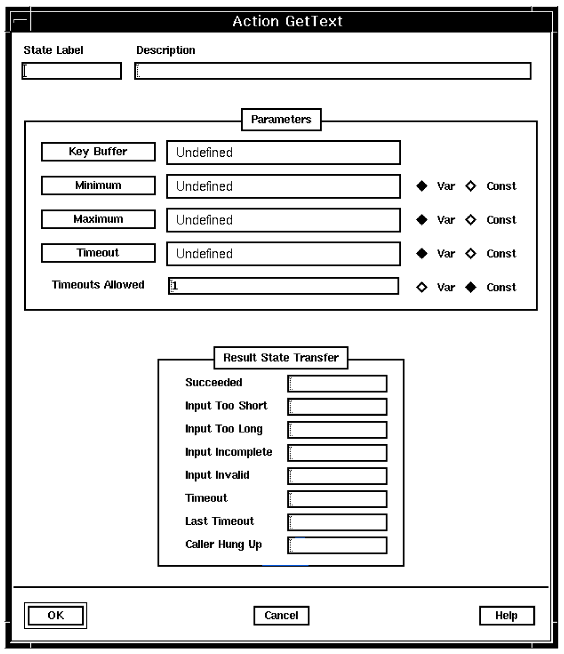Purpose
Use GetText to retrieve information that is provided by a caller as a series of letters.

Description
Use GetText to retrieve information that is provided by a caller as a series of letters. The Key Signals system parameter group maps letters to the keys on the telephone keypad.
To enter a letter, the caller presses two keys. The first key is the key on which the letter appears. The second key indicates which of the letters mapped to that key is the one the caller wants. The first position in the map is 0, the second position is 1, and so on.
For example, if the keys are mapped as printed on telephone keypads in the United States, the map for key 2 can be set to 2ABC. The caller presses 20 to enter the number 2 (as text); 21 to enter the letter A; 22 to enter the letter B; and 23 to enter the letter C. To enter S, the caller presses 73.
The key identified by the Stop Key system parameter in the Application Server Interface group clears the input to allow the caller to start over. By default, this is the * key. The last key pressed must be the key identified by the Enter Key system parameter in the Application Server Interface group. By default, this is the # key.
GetText causes an automatic fade out of any background music. You can override this by using the System : Music : Automatic fade before actions system variable (SV226).
Parameters
The parameters for GetText identify the variable to which the returned information is assigned and the length of the information. The parameters also define two timeouts.
- Key Buffer. Specifies the variable to which the caller’s input is transferred. The variable must be a string variable.
- Minimum. Specifies the smallest number of letters that a caller must enter.
- Maximum. Specifies the largest number of letters that a caller can enter.
- Timeout. Specifies the number of seconds that GetText waits for the caller to enter information.
- Timeouts Allowed. Specifies the maximum number of timeouts allowed
for this GetText action. When the Timeouts Allowed value is reached, the application
branches to the state identified for the Last Timeout result.
The timeout counter retains its value until a new Get action (GetText, GetData, GetFindData, GetFindName, GetKey, or GetPassword) is encountered.
The timeout counter applies to the current line of the state table. When the Last Timeout result has been returned, the counter is reset. Also, note that the debugger treats each statement, or line, as a separate state table, so two consecutive Get actions appear as one action to Blueworx Voice Response. Last Timeout could therefore be returned when Timeout is expected. This is a limitation of the debugger.
The Last Timeout result is returned for any GET action if fax detection is turned on, and is detected. Check SV180 to see if fax was detected.
Possible results
GetText can have one of the following results:
- Succeeded
- The text provided by the caller has been assigned to the variable.
- Input Too Short
- The caller did not enter as many letters as are required by the value of Minimum.
- Input Too Long
- The caller entered more letters than are allowed by the value of Maximum.
- Input Incomplete
- The caller did not press the pound key.
- Input Invalid
- The caller entered a two-key sequence in which the second key does not correspond to the first key map. For example, if the keys are mapped with three letters each, starting with ABC on key 2, and the caller presses 2 and then 4, GetText will result in Input Invalid.
- Timeout
- The time defined by Timeout has elapsed and the caller has not entered the information.
- Last Timeout
- The application has repeated this GetText action for the number of times defined by the value of Timeouts Allowed.
- Caller Hung Up
- The caller has hung up.
ASCII syntax
When using an ASCII editor, code this action with these parameters in the following order:
- Key Buffer input, local or system variable
- Minimum
- Maximum
- Timeout
- Timeouts allowed
For example:
getinput: "Check Edges" GetText(loc3_s, 12, 25, 10, 5) edge EDGE_GETT_LEN_OK: len_ok edge EDGE_GETT_TOO_SHORT: too_short edge EDGE_GETT_TOO_LONG: too_long edge EDGE_GETT_INCOMPLETE: incomplete edge EDGE_GETT_INVALID_ENTRY: invalid_entry edge EDGE_TIMEOUT: timeout edge EDGE_LAST_TIMEOUT: last_timeout edge EDGE_HUP: hup ;
The parameters and edges are described above under "Parameters" and "Possible results". For more information, see Testing a state table using the debugger.